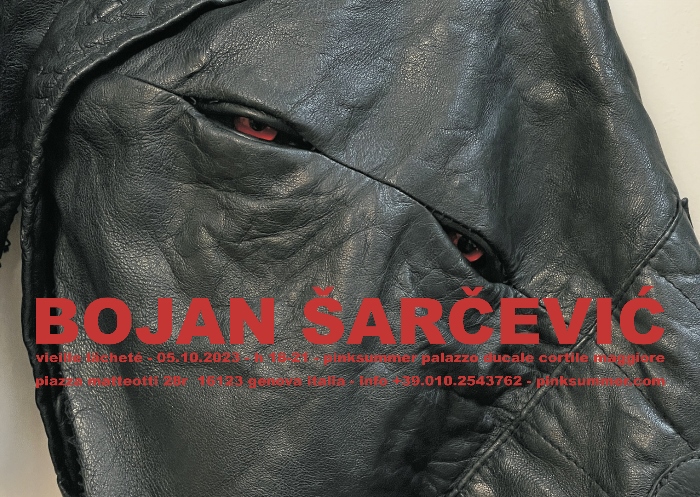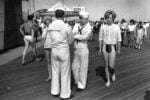Bojan Šarčević – Vieille Lâcheté

Vieille Lâcheté è il titolo del nuovo progetto di Bojan Šarčević e della sua sesta mostra personale da Pinksummer. Queste opere rappresentano bene quello che chiamiamo “formalismo esistenziale”.
Comunicato stampa
Vieille Lâcheté è il titolo del nuovo progetto di Bojan Šarčević e della sua sesta mostra personale da Pinksummer. Queste opere rappresentano bene quello che chiamiamo “formalismo esistenziale”, definizione che potrebbe apparire pomposa, ma che in sostanza significa che Šarčević spesso esplora l’idea che la vera essenza della vita risieda nei limiti e nei confini che dobbiamo affrontare. Questi confini sono come il fondamento della vita, con tutti i suoi alti e bassi.
Se si parla di trascendenza rispetto all’opera di Šarčević, non si tratta di qualcosa che ha a che fare con il divino. È piuttosto la vivida consapevolezza del vuoto o del nulla. Questa consapevolezza lo spinge a creare opere che tendono all’impossibile o a dare forma a cose che non possiamo toccare o vedere.
Lacan una volta disse che il reale è come un uccello rapace che si nutre di azioni dotate di significato, anche se il mondo in sé non ha alcun significato intrinseco.
Le persone che vivono nel reale, nello spazio e nel tempo, sentono spesso che la propria esistenza è costantemente a rischio.
Da parte sua, Šarčević non è tanto interessato a rendere l’esistenza come un affare importante o un progetto impegnativo. Si concentra più sul modo in cui la nostra esistenza lascia naturalmente il segno nel mondo senza che noi nemmeno ci abbiamo tentato.
Andando indietro quando tenne la sua prima mostra personale da Pinksummer nel 2002, Šarčević ha detto qualcosa di particolarmente interessante. Sostanzialmente ha parlato di come il nostro modo di essere diventa completo quando smettiamo di pensare a qualcosa di più grande (il trascendente) come a una cosa misteriosa e iniziamo a vederlo semplicemente come una parte naturale della vita (immanente). Ha anche accennato al fatto che le cose vere e assolute riguardano il presente e l’essere spontanei. Ma non bisogna confondere la spontaneità con l’ingenuità; si tratta di qualcosa che puoi migliorare con la pratica.
In questa mostra personale, Šarčević si è ispirato agli abiti. Non è la prima volta che gioca con i vestiti. I vestiti sono molto vicini al nostro corpo, come una seconda pelle, che, tra l’altro, è in realtà l’organo più grande e più pesante del nostro corpo. La nostra pelle è la prima parte di noi che percepisce ciò che accade nel mondo esterno, se fa caldo o freddo o se qualcosa ci fa sentire bene o ci mette in allerta: in Vieille Lâcheté, Šarčević ha armeggiato con un tipo speciale di abbigliamento che è piuttosto interessante se paragonato alla nostra pelle. Stiamo parlando delle giacche di cuoio, indumenti di pelle animale come quelli che l’uomo utilizza da sempre per riscaldarsi. Ma in tempi moderni sono diventate anche un simbolo di ribellione e di sfida.
In questa mostra Šarčević ha fatto qualcosa di singolare. Ha sostanzialmente disumanizzato vecchie giacche di pelle smontandole e aggiungendovi occhi vitrei e realistici, come quelli che si vedono sugli animali tassidermizzati. Ha trasformato queste giacche in una forma d’arte, in una sorta di rappresentazione.
L’artista attraverso queste giacche sembra voglia risvegliare i sentimenti di paura reconditi, gli antichi terrori e le angosce dentro di noi.
E, giusto perché lo sappiate, questa non è la prima volta che Šarčević gioca con i vestiti. Ripensiamo al 1999, quando fece indossare quegli stivali a un addetto all’irrigazione/
Pensiamo a cosa ha fatto Šarčević nel 2000 con Favorite Clothes Worn while S/He Worked. Ha convinto 15 lavoratori, tra cui panettieri, meccanici e collaboratori domestici, a indossare abiti firmati fantasiosi mentre erano al lavoro. Quindi, ha esposto questi vestiti logori e sporchi come reperti di un museo. È quasi come se volesse celebrare il lavoro manuale e il modo in cui il nostro lavoro plasma ciò che siamo.
E non dimentichiamo la sua mostra più recente nel 2020 alla galleria Frank Ebalz di Parigi, il titolo era L’Extime. Lì, c’erano tre manichini di plastica muscolosi e dall’aspetto virile con teste scolpite nella pietra che indossavano morbide camicette di seta che avevano uno stile super elegante tipico degli anni '80 (una sorta di Homo Sentimentalis?). Era come se questi vestiti trasformassero le emozioni in qualcosa di prezioso. Ma ricorda, i nostri sentimenti non sempre seguono la nostra volontà.
Press Release
Vieille Lâcheté is the name of Bojan Šarčević’s new art project and solo exhibition at Pinksummer gallery. These works represent what we call “existential formalism,” a big term that basically means Šarčević often explores the idea that life’s true essence lies within the limitations and boundaries we face. These boundaries are like the foundation of life, including all its ups and downs.
When we talk about transcendence in Šarčević’s work, it’s not about anything divine. Instead, it’s about this vivid awareness of emptiness or nothingness. This awareness brings him to create things that seem impossible or give form to things we can’t touch or see.
Lacan once said that the real world is like a bird of prey that feeds on meaningful actions, even though the world itself doesn’t have any built-in meaning. People who live in the real world, in space and time, often feel their existence is constantly at risk.
In this part, Šarčević isn’t so much into making existence a big deal or some grand plan. He’s more about how our existence naturally leaves its mark on the world without us even trying.
Way back when he had his first solo show at Pinksummer in 2002, Šarčević said something interesting. He basically talked about how our way of being becomes complete when we stop thinking of something bigger (the transcendent) as this mysterious thing and start seeing it as just a regular part of life (immanent). He also mentioned that true, absolute stuff is all about the present moment and being spontaneous. But don’t mix up spontaneity with being naive; it’s something you get better at with practice.
In this solo exhibition, Šarčević gets creative with fashion clothes. It’s not the first time he’s played around with clothing. Clothes are super close to our bodies, like a second skin, which, by the way, is actually the biggest and heaviest organ in our bodies. Our skin is the first thing that feels what’s happening in the outside world, like whether it’s hot or cold or if something feels good or hurts: In Vieille Lâcheté, Šarčević tinkered with a special type of clothing that’s quite interesting when you compare it to our skin. We’re talking about leather jackets, like the ones made from animal that people have used to stay warm since ancient times. But in modern times, they’ve also become a symbol of rebellion and defiance.
In this exhibition, Šarčević did something unique. He basically “dehumanized” old leather jackets by taking them apart and adding glassy, lifelike eyes to them, like what you’d see on a taxidermied animal. He turned these jackets into a form of art, a representation of sorts. It’s almost like he wanted us to look at these jackets and think about what they mean to us and the scary feelings they might stir up – like old fears and anxieties.
And, just so you know, this isn’t the first time Šarčević has played around with clothing. Think back to 1999 when he had those boots worn by an Irrigation/Fertilization worker. Those boots mysteriously leaked liquid, soaking everything during the worker’s busy day.
Think about what Šarčević did in 2000 with Favorite Clothes Worn while S/He Worked. He got 15 workers, like bakers, mechanics, and domestic helpers, to wear fancy designer clothes while they were on the job. Then, he displayed these worn and dirty clothes like museum exhibits. It’s almost like he wanted to celebrate manual labor and how our jobs shape who we are.
And let’s not forget his more recent exhibition in 2020 at the Frank Ebalz gallery in Paris, called “L’Extime.” There, he had three muscular, manly-looking plastic mannequins with stone-carved heads wearing these soft silk blouses that had a super classy 1980s style (kind of like “Homo Sentimentalis”?). It was as if these clothes turned emotions into something valuable. But remember, our feelings don’t always follow our will.



